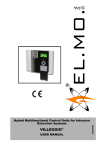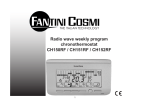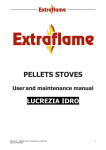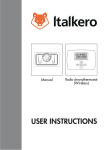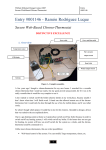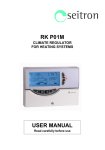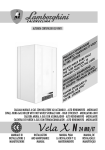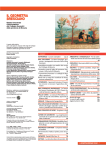Download EQUICALOR®
Transcript
EQUICALOR® USER’S GUIDE Wireless system for independent management of thermal regulation 300546US-03-14 PA TE NT E D • DC 1010 300546US-03-14 QUICK GUIDE INSTALLING THE EQUICALOR SYSTEM 1) Identify the zones Plan out the division of the house into zones, determining the quantity. 2) Define a position for the chronothermostat The chronothermostat measures the temperature of the room where it is installed; therefore, it must be in a position exposed to good air circulation, at 5 ft above the floor. See Typical placement of device on pg. 10. 3) Chronothermostat wall installation Secure the chronothermostat in the desired position and connect it to the boiler. Refer to Wall installation on pg. 11. CAUTION! Make sure to cut-out the mains voltage to the electrical system before carry out this procedure. 4) Insert the batteries in the chronothermostat The chronothermostat requires 3 AA 1.5 V Alkaline batteries. To insert the batteries refer to Battery replacement on pg. 5. 5) Setting the language, date and time Enter the data for first start up, as indicated in the paragraphs Current language, Date and Time (Set time) on pg. 7. To use the control keypad see Chronothermostat Configuration and Menu Navigation on pg. 6. 6) Configuring the zones Set the number of zones in the house, as indicated in the paragraph Number of managed zones on pg. 19. To access the function refer to Chronothermostat Configuration on pg. 6. 7) Insert the batteries in the actuator Each actuator requires 3 AA 1.5 V alkaline batteries. To insert the batteries refer to Battery replacement on pg. 16. 8) Installing the actuator Install the actuators on their respective radiators. Refer to Installing the actuator on pg. 17. 9) Associate all the actuators to the chronothermostat and test them Refer to the chapter Association of an actuator with the chronothermostat on pg. 19. INDEX 1. CHRONOTHERMOSTAT Features of the chronothermostat Contents of the package Display and control keys Warnings List of alarms Chronothermostat conditions of warranty Contacts Battery replacement Operating modes Chronothermostat configuration Automatic temperature setting Installing the chronothermostat Technical characteristics of the chronothermostat pg. 3 pg. 3 pg. 3 pg. 4 pg. 4 pg. 4 pg. 4 pg. 5 pg. 5 pg. 6 pg. 9 pg. 10 pg. 12 2. ACTUATOR Features of the actuator Contents of the package Led indicator and front selector switch Warnings Technical characteristics of the actuator Battery replacement Remote sensor Room comfort temperature adjustment Installing the actuator Manual release pg. 14 pg. 14 pg. 14 pg. 14 pg. 15 pg. 16 pg. 16 pg. 16 pg. 17 pg. 17 3. TECHNICAL SECTION 3 . 1 (CHRONOTHERMOSTAT) Chronothermostat - setup Association of an actuator with the chronothermostat 3 . 2 (ACTUATOR) Actuator – setup pg. 18 pg. 19 pg. 20 4. FUNCTION NAVIGATION MAP pg. 22 5. APPENDIX pg. 23 [3] 300546US-03-14 CHRONOTHERMOSTAT 1. CHRONOTHERMOSTAT INTRODUCTION The EQUICALOR system consists of a chronothermostat and integrated zone actuators. The chronotermostat can control your plant, managing temperature control. The actuators are installed directly on the radiators to regulate operation in each room. Both the heating and cooling functions of EQUICALOR guarantee optimal room temperature and energy savings during times of the day when the rooms are not occupied. The information contained in this manual will help simplify the customisation of the system and the consequent reduction in the plant operating costs. FEATURES OF THE CHRONOTHERMOSTAT The EQUICALOR-AC chronothermostat is able to independently manage the individual rooms, controlling up to 8 zones. It also allows direct control of the wallmounted boiler. CONTENTS OF THE PACKAGE • Chronothermostat • Stylus alkaline batteries • This user’s manual DISPLAY AND CONTROL KEYS The Control keys are composed of: • Right multi-function key (1) • Left multi-function key (5) • ‘Reset’ key (2) • Four navigation keys (3) • ’OK-MODE’ button (4) DISPLAY CONTROL KEYS NOTE: If the key lock is not active, simply touch keypad and it will become operational. (D) (E) (F) (G) (H) (I) (D1) (L) (C) The Display has the following fields: • Navigation keys icon (A) • Left multi-function key field: ‘MENU/EXIT/ CANCEL’ (B) • 7-DAYS Schedule Graph (C) T1, T2, T3 (see note below*) • Mode enabled (D) • Temporary mode on (D1) • Set temperature (E) • Currently selected zone (F) • Temperature reading <only ZONE1> (G) • WINTER mode , SUMMER mode and Alarm Reminder (H) • Date (I) and Time (L) • Right multi-function key field: ’ENTER/EDIT/ ENTER/VIEW/D. SAVING (M) (M) (B) (1) (5) (A) (4) (3) (2) For help see ‘NAVIGATION MAP’ on pg. 22 *temperature: T1=T comfort T2=T saving T3=T limit CHRONOTHERMOSTAT [4] 300546US-03-14 WARNINGS 1 . Adjustment of the chonothermostat’s advanced settings should preferably be carried out by the installer. 2 . It is important to verify that the batteries are working properly to prevent the heating/cooling system from shutting down due to a lack of power to the chronothermostat. 3 . Observe the following directions for using the batteries: when it is time to dispose of them, place them separately into the appropriate recycling container; follow the installation instructions provided; when the device is not used for a prolonged period of time, make sure to remove the batteries; avoid connecting the metal poles that are in contact with the batteries in order to prevent a short circuit; always use the type of batteries specified in this manual; do not mix different batteries, old and new batteries or alkaline batteries with standard or zinc coal batteries; the use of rechargeable batteries results in less operating autonomy when compared to non-rechargeable batteries. 4 . If the device causes interference with other electrical equipment, immediately remove them from the area. 5 . Do not dispose of the device in the environment at the end of its life cycle. Dispose of the device in compliance with current legislation. 6 . The chronothermostat must only be installed by authorised personnel in accordance with current legislation and regulations and with the mains voltage switched off. 7 . In the event of a problem(s), a ‘List of Alarms’ appears when the display is switched on. See the following paragraphs. LIST OF ALARMS In case a working error occurs, the system keeps track of the anomaly. If the error persists, a warning is shown when the display lights up for the first time. This message can be read at any time in section ‘Alarm history’ for full details. (See relative paragraph on pg. 18) The access path is as follows: MENUàSETTINGSàAD- CHRONOTHERMOSTAT CONDITIONS OF WARRANTY I.V.A.R. S.p.A. is insured against damage caused to third parties due to product manufacturing defects in accordance with the terms and limits set out in Legislative Decree 206/2005. The maximum insurance coverage is € 3,000,000.00 per claim, per year. The liability of IVAR for damages caused by defective products is governed by the general sales conditions and by Legislative Decree 206/05 (art.114-127) and is valid for 2 years after the product’s installation. I.V.A.R. S.p.A. ensures the compliance and the proper functioning of its products in accordance with the terms of Legislative Decree 206/05. VANCED SETINGS àPLANTàDIAGNOSTICSàALARM HISTORY NOTE: the icon Alarm Reminder ’ ’ appears in case of error and turns off as soon as the ‘HISTORY’ menu has been opened. CONTACTS IVAR US, Inc. Mailing Address: PO Box 8015, Elkridge, MD 21075 T:1-855-9-IVAR-US www.ivar-us.com [email protected] I.V.A.R. S.p.A. Via IV Novembre, 181 25080 Prevalle (BS) - Italy T: +39 030 68028 - F: +39 030 6801329 www.ivar-group.com [email protected] [5] 300546US-03-14 BATTERY REPLACEMENT The chronothermostat requires 3 AA 1.5 V Alkaline batteries. The batteries must be inserted in order to operate the equipment. FIG. 1 1 To insert or replace the batteries, open the front panel of the chronothermostat (See figure-1). Then, place the batteries in their housings (B1, B2, B3), making sure to place them in the direction indicated on the bottom of each housing (See Figure-2). FIG. 2 B1 CHRONOTHERMOSTAT OPERATING MODES The Chronothermostat operates in three different modes: Automatic, Manual and OFF. The Enabled Mode icon indicates which of the three modes is currently enabled. To activate the display, simply touch any key. During normal chronothermostat operation, the display will show the information regarding the status of the system relative to the mode currently enabled for 30 seconds (When operating in ‘Automatic mode’ the Currently selected zone icon specifies the zone to which the information refers. To review the different zones, use the Left/Right arrows). To switch from one mode to another, press OK-MODE repeatedly until the desired mode is displayed. Manual Mode [MENUàMODEàMANUAL MODEàENABLE MANUAL MODE] Defines a set temperature that will be maintained in all the zones (SET TEMPERATURE). B2 B3 NOTE: When switched on, the display prompts selection of the language, time and date; the default language is English (To complete this procedure, see ‘Menu Navigation on pg. 6. This paragraphs explains how to use the control keypad). The low battery alarm (L BATT) indicates that the batteries are almost discharged and that they will continue to function in anti-freeze mode for 15 days, until they are fully discharged; therefore, they must be replaced to restore operability. For more information about the alarms, see ‘Diagnostics (Alarm History)’ on pg. 18; the alarms concern both the chronothermostat and the actuators. Removing the batteries does not cancel the settings made. The Up/down keys (navigation keys) are used to change the Set temperature, increasing or decreasing it by 1°F. Switching to another mode, interrupts the Manual mode. Shutdown mode [MENUàMODEàSHUTDOWN MODEàSHUTDOWN] Shutdown mode disables the system, switching to the anti-freeze mode. This program ensures a minimum ambient temperature of 41 °F to protect the system. On the display the time, date and temperature can be read. It is also possible to access the menu. NOTE: to maintain the Manual or Shutdown mode for a For help see ‘NAVIGATION MAP’ on pg. 22 CHRONOTHERMOSTAT defined period of time, see the paragraph ‘Automatic Temperature setting’ on pg. 9. [6] 300546US-03-14 2 - scroll the list with the UP/DOWN keys to select ‘Start up optimization‘ and then press the right multi-function key to edit. Automatic mode [MENUàMODEàAUTOMATIC MODEàENABLE AUTOMATIC MODE] For information regarding this mode, see pg. 9. CHRONOTHERMOSTAT CONFIGURATION To configure the chronothermostat options you must access the MENU. If the display is off, activate it by simply pressing any key. Press the Left multi-function key as shown to view a list of sections. To start, press the left multi-function key Menu Navigation Using the Up/down keys (navigation arrows), select the required field. Press OK or the Right multi-function key to access the highlighted option. Some advanced options require pressing ENTER another time before you can proceed. The header shows the name of the page for easier navigation. The following example shows the procedure for accessing the ‘Start up optimization’ option 1 - scroll the list with the UP/DOWN keys and select ‘Preferences‘ and then press the right multi-function key to access. In the various editing options, the Multi-function keys allow proceeding step by step until these procedures are complete. Refer to the following list (Note that after 30 seconds, if no key is pressed, the system switches off the display, exiting the menu). List of key functions (multi-function and arrow keys) • ENTER to access a section. • EDIT to begin a procedure. • ENTER to complete a procedure after editing. • VIEW to consult a page. • EXIT to close a section. • CANCEL to go back without completing the edit. • STANDARD/D. SAVING to change the time. • Up/down (navigation arrows) to scroll through a list or edit a temperature, date or time value. Using the arrows, press down to edit faster. • Left/right (navigation arrows) to switch from one value field to another. NOTE: refer to the ‘Function navigation map’ on pg. 22 for the complete list of the menu sections and their relative access path. NOTE: at the beginning of each function description, its access path is indicated; for example: [MENUàSETTINGSàCURRENT LANGUAGE]. 300546US-03-14 [7] SETTINGS - ASSOCIATIONS -PREFERENCES A list of menu sections follows. Reset [‘reset’ KEY] If an anomaly is noted, manually restart the device. To do this, press the Reset key on the keypad using a pencil or paper clip. NOTE: the settings defined previously are NOT lost during this operation. CHRONOTHERMOSTAT Time (Daylight saving time) [MENUàSETTINGSàTIMEàD.SAVING TIME] Access the Daylight saving time section to manage the time change. Use the Up/down keys to edit the settings. Select ON to activate the time change, or OFF to maintain the standard time throughout the year. When finished, press ENTER. After having activated the time change, during normal operation, the display will indicate the type of time enabled (see Figure-3). Current language FIG. 3 [MENUàSETTINGSàCURRENT LANGUAGE] The chronothermostat provides for the use of 9 languages (Italian, English, French, German, Spanish, Portuguese, Flemish, Czech, Norwegian). Access the Current Language section (See ‘Menu Navigation’ on pg. 6). To edit the language option, use the Up/down keys and select the desired language from the list. Press ENTER to complete the procedure. Date [MENUàSETTINGSàDATE] Access the Date section to change the current date (See ‘Menu Navigation’ on pg. 6). Use the Left/right key to switch from editing the ‘day’ to editing the ‘month’ or ‘year’. Press Up/down to change the day/month/year. Press ENTER to complete the procedure or CANCEL to exit the procedure and return to the previous menu without making any changes. Time (Set Time) In this case, every time the Right Multi-function key is pressed the time changes from standard to daylight saving time and vice versa, allowing the clock to be updated on the date established. Summer set, Winter set, Zones, Summer adjustment, Summer/Winter Mode [MENUàSETTINGSà...] See pg. 9. Contrast and Brightness Adjustment [MENUàSETTINGSàTIMEàSET TIME] Access the Set time section to change the current time (See ‘Menu Navigation’ on pg. 6). Use the Left/right key to switch from editing ‘hours’ to editing ‘minutes’ and vice versa. Press Up/down to change the hours/minutes of a unit. Press ENTER to complete the procedure. [MENUàSETTINGSàCONTRAST] [MENUàSETTINGSàBRIGHTNESS] These control the contrast of the display and the intensity of the backlighting. Use the Up/down arrows to select a new adjustment and then press ENTER. The default brightness setting is ‘Minimum’, which ensures optimal battery life. Key lock [MENUàSETTINGSàKEY LOCK] Access the Key lock section to enable and disable this function. 1) Select ON, using the Up/down keys to protect the device from accidental changes being made. Then press ENTER. In this case, if the keypad has not been used for thirty seconds, the display lighting switches off and the keypad is locked. For help see ‘NAVIGATION MAP’ on pg. 22 CHRONOTHERMOSTAT With each subsequent touch of the keypad, the display will light up for 10 seconds and indicate the key to press to unlock the keypad. 2) Select OFF to cancel the protection and then press ENTER. In this case, the display will light up at each touch of the keypad until the next shutdown, which occurs after 30 seconds of inactivity. [8] 300546US-03-14 and OFF disables it. Use the Up/down arrows to edit the setting and then press ENTER. The optimization process is self-regulating and its precision during normal operation is refined each day, improving yield. If the Start up optimization is enabled, start up takes place in advance so that the Comfort temperature is effectively reached at the precise moment set in the programming parameters. Similarly Shutdown optimization (if enabled) will anticipate shutdown in order to obtain an optimized temperature Ts when entering the T2 time band (Ts=T1-Tred with Tred equal to the value of Prestart savings reduction). Zone names [MENUàPREFERENCESàSET ZONE NAMES] Associations [MENUàASSOCIATIONS] Refer to the paragraph ‘Association of an actuator with the chronothermostat‘ on pg. 19 . Time format (12, 24) [MENUàPREFERENCESàTIME FORMAT] Allows you to customize the names of each zone. To begin, select a zone using the Up/down arrow and then press ENTER. Use the Up/down arrows to change a letter and the Left/Right arrows to move to the next letter. Follow the instructions in the ‘Character scroll bar’, located under the name, to compose text. If this option is changed, the time field will be expressed in format 24 (e.g.: 18:25) instead of format 12 (e.g.: 6:25 PM). Use the Up/down keys to configure the option. When finished, press ENTER. Temperature measurement units [MENUàPREFERENCESàTEMPERATURE MEASUREMENT UNITS] If this option is changed, all the temperatures will be expressed on the display in Celsius instead of Fahrenheit. Use the Up/down arrows to edit the setting and then press ENTER. Start up and shutdown optimization (Functions only active in Winter mode) [MENUàPREFERENCESàSTART UP OPTIMIZATION] [MENUàPREFERENCESàSHUTDOWN OPTIMIZATION] Allows enabling plant pre-activation and anticipated shutdown in ‘Automatic Mode’. ON enables optimization To delete a letter, select the ‘Blank’ at the end of the bar. When finished, press ENTER to make the change. [9] 300546US-03-14 CHRONOTHERMOSTAT AUTOMATIC TEMPERATURE SETTING ‘Winter Set’ and ‘Summer Set’ Enable Automatic Mode (Automatic Mode) [MENUàSETTINGSàWINTER SET] [MENUàSETTINGSàSUMMER SET] Access the Mode section and select Automatic Mode using the Up/down arrows (See ‘Menu Navigation’ on pg. 6 for further instructions). Then press ENTER twice, to activate the option. Winter/Summer Mode [MENUàSETTINGSàWINTER/SUMMER MODE] Enables the system to control heating and cooling, giving priority to the winter set or summer set, respectively (For information on the sets see the following paragraphs). Access the Winter/Summer Mode and use the Up/down arrow to select Winter or Summer, then press ENTER. FIG. 4 7-DAYS SCHEDULE GRAPH (EXAMPLE) 3 6 9 12 15 18 21 LINE 1 – e.g.: 68° LINE 2 – e.g.: 65° LINE 3 – e.g.: 62° In this example, the temperature will be 68 degrees from 18:00 to 20:00, 65 degrees from 20:00 to 21:30 and 62 degrees from 21:30 to 24:00. Access the Winter Set section or the Summer Set section depending on the mode you wish to work in (see ‘Summer/Winter Mode’). Use the Up/down to highlight the required field and then press ENTER. Using the Up/down arrows, select Set comfort to customize temperature T1, Set saving for T2, or Set limit for T3. By appropriately adjusting the Saving and Limit temperatures, the user is able to perfect saving management. Highlight a field and press ENTER. With every touch of the Up/down arrows the temperature value increases or decreases by 1 °F. When finished, press ENTER. Zones - Weekly Schedule [MENUàSETTINGSàZONES] When the WINTER mode is enabled, access the Zones section to customize the 7-DAYS Schedule Graph of any zone in the home (This section lists many zones, or rather the number defined using the ‘Number of managed zones’ option - see pg. 19). The initial number of zones is 2 and this can be increased to a maximum of 8). Select a zone with the Up/down arrows and press ENTER. Using the Up/down arrows select the day of the week you wish to set and press ENTER. Now use the Left/right buttons to highlight the time bands to be edited (48 vertical markers divide the day into 30 min intervals). Then press Up/ 18 21 down to assign T1, T2 or T3 For help see ‘NAVIGATION MAP’ on pg. 22 FROM 21:30 TO 24:00 It is therefore possible to set, for each of the 7 days, during which time bands to offer the Comfort (T1), Saving (T2) or Limit (T3) temperature. To define the 3 temperature ranges into which the in 7-DAYS Schedule Graph is divided, proceed as follows (the 3 ranges are represented by the horizontal lines of the graph; see Figure-4 and ‘Managing the temperature sets’ on pg. 23). FROM 20:00 TO 21:30 If Automatic mode is enabled, the chronothermostat follows a weekly schedule to control the system. FROM 18:00 TO 20:00 [MENUàMODEàAUTOMATIC MODEàENABLE AUTOMATIC MODE] CHRONOTHERMOSTAT to the time interval selected. To complete the change, press ENTER. It is immediately possible to decide whether to apply the same programming to the following 24 hours. To extend it by one day, respond to the system prompt by selecting ENTER and then EDIT. Repeat the operation until a typical week has been defined. Summer adjustment - Weekly Schedule [MENUàSETTINGSàSUMMER ADJUSTMENT] When the SUMMER mode is enabled, access Summer Adjustment (*) to define the weekly schedule. Refer to the similar procedure, described in the previous paragraph (Zones). Manual for 1 hour and then Auto (Manual Mode) [MENUàMODEàMAN. MODEàMANUAL FOR 1 HOUR...] [MENUàMODEàMAN. MODEàMANUAL FOR 2 HOURS...] Access the Manual Mode section and select Man. for 1 hour and then auto, using the Up/down arrows, to temporarily activate this mode, and then press ENTER. Alternatively, select Man. for two hours and then auto or Set duration of manual mode to define longer durations. Then press ENTER. In the second case, to set this duration, use the Up/down arrows and define the required period of time. Then press ENTER to complete. If you want to specify a period longer than 24 hours, the system automatically switches to count days. NOTE: using this mode, for example, it is possible to manage the plant during a holiday period. In fact, proper program setting, ensures an anticipated return to conditions of comfort with respect to the scheduled date of return from the holiday. Shutdown for 1 hour and Auto (OFF Mode) [MENUàMODEàOFF MODEàSWITCH OFF FOR...] [10] 300546US-03-14 INSTALLING THE CHRONOTHERMOSTAT Follow the instructions below to operate device: 1) Choose a location for the device and mount it on the wall. 2) Insert the batteries. 3) Associate each actuator to the chronothermostat, defining the various zones of the building. (See the paragraph, ‘Association of an actuator with the chronothermostat‘ on pg. 19). Typical placement of device The chronothermostat measures the temperature of the room where it is installed; therefore, it must be in a position exposed to good air circulation, at 5 ft above the floor. The following instructions must be followed. • DO NOT place near a radiator. • DO NOT place near doors. • DO NOT place on perimeter walls. • DO NOT place in correspondence to piping inside the walls. • DO NOT place in rooms with exceptional temperature and humidity conditions (For example the kitchen and bathroom). • DO NOT place where the device may come into contact with water. • DO NOT expose to direct sunlight. NOTE: when placing the thermostat, it is necessary to verify that the actuators are located within a certain range. In ideal conditions - without any obstacles - this range covers 33 yd. Among the factors that can affect transmission performance, humidity and the architectural features of the building must be considered. 1 ft 5 ft Access the OFF mode section and follow the same procedure (See previous paragraph). * ATTENTION: in ‘Summer adjustment’ selecting the zones is not necessary. In Summer mode the system operates in ON/OFF mode on all the actuators and on a single zone, whose temperature is measured directly by the chronothermostat. It is possible to disable the summer operation of one or more of the actuators (See Anti-condensation function adjustment on pg. 23). 300546US-03-14 [11] Wall Installation 1) Open the front panel of the chronothermostat. CAUTION! Make sure to cut-out the voltage to the electrical system before proceeding beyond this point. CHRONOTHERMOSTAT S1 3 1 S S1 2) After loosening the 2 screws, remove the lid of internal box (S), as shown in the figure at the side. Next pass the boiler contact cables through the slot (S1). Connect the power cables to the terminal in positions ‘NO’ and ‘C’, as indicated at the bottom of the lid (See the ‘Wiring diagram’ on pg. 13 for further instructions). Lastly, put the lid back on to close the box and then tighten the screws. 2 1 x2 UNSCREW 3) Place the device against the wall, and secure it as shown (3). The possible options are as follows: • with 2 screws in correspondence to the 503E electrical box (*A) • with 2 screw anchors on the wall (*B) * A (box-mounted) 3 3 * B (wall mounted) 3 3 For help see ‘NAVIGATION MAP’ on pg. 22 CHRONOTHERMOSTAT TECHNICAL CHARACTERISTICS OF THE CHRONOTHERMOSTAT 1) TRANSMISSION • Transmission frequency: 915.00 MHz • Signal range: 33 yd with no obstacles 2) POWER SUPPLY • Voltage: 4.5V • Type of batteries: 3 AA stylus alkaline batteries (mod. LR6) 1.5V • Outlet type - unipolar contact relay 5A/250Vac - FOR US MARKET: DO NOT CONNECT VOLTAGE HIGHER THAN 24V ac/dc TO THE OUTPUT RELAY! • battery life: 3 years (with brand new, well stored batteries and in optimal operating conditions)* • Type of action, disconnection and device: 1 / B / Digital electronic 3) ENVIRONMENTAL CONDITIONS • Temperature limits for transport and storage: from -4 °F to +130 °F • Operating temperature limits: from 23 °F to +110 °F 4) BATTERY STORAGE CONDITIONS • Temperature: 68 °F ensure long battery life [12] 300546US-03-14 5) CONFORMITY • Reference Standard (LV): IEC 60730-2-9 • Reference Standard (EMC): FCC 15 par. 15.247 6) SAFETY • Protection rating: IP 40 • Type of insulation: CLASS II 7)OVERALL DIMENSIONS • Chronothermostat: L=4.95 in, H=3.90 in, W=1.00 in 8) PRODUCT CODE • Description: digital chronothermostat with backlit display and SUMMER / WINTER switch. • EQUICALOR-AC: Art. DC 1010 Code 506366US 9) TEMPERATURE INTERVALS • Sample interval: 10 minutes • Hysteresis: 0.2°F. * battery life may be shortened by bad RADIO transmission conditions (L SIGN), by the presence of obstacles or by storage conditions other than those prescribed. Batteries of different brands may have different behaviour and lower life than indicated in the present document. FCC ID: 2AB4Y506366US This device complies with part 15 of the FCC Rules. Operation is subject to the following two conditions: (1) this device may not cause harmful interference, and (2) this device must accept any interference received including interference that may cause undesired operation. NOTE: this equipment has been tested and found to comply with the limits for a Class B digital device, pursuant to Part 15 of the FCC Rules. These limits are designed to provide reasonable protection against harmful interference in a residential installation. This equipment generates, uses, and can radiate radio frequency energy and, if not installed and used in accordance with the instructions, may cause harmful interference to radio communications. However, there is no guarantee that interference will not occur in a particular installation. If this equipment does cause harmful interference to radio or television reception, which can be determined by turning the equipment off and on, the user is encouraged to try to correct the interference by one or more of the following measures: • Reorient or relocate the receiving antenna. • Increase the separation between the equipment and receiver. • Connect the equipment into an outlet on a circuit different from that to which the receiver is connected. • Consult the dealer or an experienced radio/TV technician for help. RF Exposure: this equipment complies with FCC radiation exposure limits set forth for an uncontrolled environment. This equipment is in direct contact with the body of the user under normal operating conditions. This transmitter must not be co-located or operating in conjunction with any other antenna or transmitter. Warning: Changes or modifications to this device not expressly approved by IVAR Spa could void the user’s authority to operate the equipment. [13] 300546US-03-14 10) WIRING DIAGRAM CHRONOTHERMOSTAT 11) APPLICATION EXAMPLES • application example 1: boiler • electrical connection FIG. 8 FIG. 7 BOILER or ZONE VALVE C NO CHRONO • application example 2: zone valve RELAY CHRONO HOUSING UNIT no. 1 CHRONO HOUSING UNIT no. 2 NC CAUTION: FIG. 9 FOR THE US MARKET DO NOT CONNECT VOLTAGE HIGHER THAN 24V ac/dc TO THE OUTPUT RELAY! CAUTION: the operating logic of the system may result in a time delay of about 15-20 minutes in the activation of the boiler contact. • application example 3: plant with two generators for WINTER/SUMMER operation. CHILLER or ZONE VALVE BOILER or ZONE VALVE 0=WINTER 1=SUMMER 0/1 C NO CHRONO NC For help see ‘NAVIGATION MAP’ on pg. 22 FIG. 10 ACTUATOR [14] 300546US-03-14 2. ATTUATORE FEATURES OF THE ACTUATOR Each actuator (sold individually; provided separately from the chronothermostat) physically controls the radiator on which it is installed, guided by the chronothermostat. If you wish to improve the comfort level of a particular room or part thereof, there is also the possibility of controlling each actuator immediately. In this way, maximum yield is obtained with accuracy and simplicity. CONTENTS OF THE PACKAGE • Actuator • Utility key • Stylus alkaline batteries • Instructions sheet LED INDICATOR AND FRONT SELECTOR SWITCH The actuator controls are found on the front side of the device. They consist of: • Led Indicator [LED from 1 to 6] • Front selector [control key] The front selector key operates in three positions: A) Position ‘+’ (HIGH) B) Position ‘SELECT’ (pressing the key) C) Position ‘-‘ (LOW) FIG. 11 ACTUATOR CONTROLS LED 1 LED 2 LED 3 A PUSH UPWARDS B FRONT SELECTOR PRESS LED 4 PUSH DOWNWARDS C LED 5 LED 6 WARNINGS 1 . During actuator installation, it is recommended that you protect the toothed ring nut using a rag when tightening. 2 . When working with the actuator make sure it does not come into contact with water and do not expose it to high levels of humidity. 3 . The actuator options setup procedure should be preferably be performed by the installer. 4 . It is important to verify that the batteries are working properly to prevent the heating/cooling system from shutting down due to a lack of power to the actuator. 5 . Observe the following directions for using the batteries: when it is time to dispose of them, place them separately into the appropriate recycling container; follow the installation instructions provided; avoid connecting the metal poles that are in contact with the batteries in order to prevent a short circuit; always use the type of batteries specified in this manual; do not mix different batteries, old and new batteries or alkaline batteries with standard or zinc coal batteries; the use of rechargeable batteries results in less operating autonomy when compared to non-rechargeable batteries. 6. If the device causes interference with other electrical equipment, immediately remove them from the area. 7 . Do not disFIG. pose of the 12 device in the environment at the end of its life cycle. Dispose of the device in A11 B* 11 compliance with current legislation. 8 . Follow the directions in Figure-12 to position the actuator. C* 11 D* 11 * See ‘Remote sensor’ on pg. 16 300546US-03-14 [15] MAX= 0.37 in CLOSING DISTANCE (X) TECHNICAL CHARACTERISTICS OF THE ACTUATOR 1) TRANSMISSION • Transmission frequency: 915.00 MHz • Signal range: 33 yd with no obstacles 2) POWER SUPPLY • Voltage: 4.5 V • Type of batteries: 3 AA stylus alkaline batteries (mod. LR6) 1.5V • Battery life: 3 years (with brand new, well stored batteries and in optimal operating conditions) * • Type of device: Digital electronic 3) CONNECTION • Type of connection: M30x1.5 • Closing distance ( X ): between 0.41 and 0.47 in MAX= Ø0.83 in M30x1,5 ENVIRONMENTAL CONDITIONS • Temperature limits for transport and storage: from -4 °F to +130 °F • Operating temperature limits: from 23 °F to +110 °F 5) BATTERY STORAGE CONDITIONS • Temperature: 68 °F ensure long battery life 6) CONFORMITY • Reference Standard (EMC): FCC 15 par. 15.247 7) SAFETY • Type of insulation: CLASS III 8) OVERALL DIMENSIONS • L=3.60 in, H=1.90 in, W=2.60 in 9) PRODUCT CODE • Description: axial servomotor • EQUICALOR-A: Art. AS 1000 Code 506364US ACTUATOR FCC ID: 2AB4Y506364US This device complies with part 15 of the FCC Rules. Operation is subject to the following two conditions: (1) this device may not cause harmful interference, and (2) this device must accept any interference received including interference that may cause undesired operation. NOTE: this equipment has been tested and found to comply with the limits for a Class B digital device, pursuant to Part 15 of the FCC Rules. These limits are designed to provide reasonable protection against harmful interference in a residential installation. This equipment generates, uses, and can radiate radio frequency energy and, if not installed and used in accordance with the instructions, may cause harmful interference to radio communications. However, there is no guarantee that interference will not occur in a particular installation. If this equipment does cause harmful interference to radio or television reception, which can be determined by turning the equipment off and on, the user is encouraged to try to correct the interference by one or more of the following measures: • Reorient or relocate the receiving antenna. • Increase the separation between the equipment and receiver. • Connect the equipment into an outlet on a circuit different from that to which the receiver is connected. • Consult the dealer or an experienced radio/TV technician for help. RF Exposure: this equipment complies with FCC radiation exposure limits set forth for an uncontrolled environment. This equipment is in direct contact with the body of the user under normal operating conditions. This transmitter must not be co-located or operating in conjunction with any other antenna or transmitter. Warning: Changes or modifications to this device not expressly approved by IVAR Spa could void the user’s authority to operate the equipment. * battery life may be shortened by bad RADIO transmission conditions (L SIGN), by the presence of obstacles or by storage conditions other than those prescribed. Batteries of different brands may have different behaviour and lower life than indicated in the present document. For help see ‘NAVIGATION MAP’ on pg. 22 ACTUATOR [16] BATTERY REPLACEMENT The actuator requires 3 AA 1.5 V Alkaline batteries. The batteries must be inserted in order to operate the equipment. 1) To replace the batteries, use the utility key, supplied in the package. 2) Release the battery slide, inserting the utility key as indicated in the figure. 2 3 3) Remove the battery housing slide and arrange the batteries in the order and direction indicated on the bottom of the slide (See Figure-13). 4) Reposition the slide, sliding it all the way until it clicks. OPEN THIS WAY FIG. 13 300546US-03-14 ROOM COMFORT TEMPERATURE ADJUSTMENT With respect to the Set temperature for a single zone in manual or automatic mode of the chronothermostat, it is possible to make an immediate modification to a certain radiator using the front selector key of the actuator concerned. For example, if two rooms are assigned to a certain zone, you are given the opportunity to increase or decrease the temperature present in either of these up to about 6 °F; or, in the same way, to obtain the best temperature for the room being used without having to worry about editing the system’s programming (See Table-1a). The procedure described below applies only actuators that are associated with areas other than Zone1. Access the Room temperature adjustment function keeping the front selector in the SELECT position, until LEDs 3 and 4 light Signal: up, which occurs after 5 seconds (See µ = Led on Table at the side). Release the selector after this signal. The Led indicator Led 1 µ indicates the actual Room temperature Led 2 µ Led 3 µ adjustment (See Table-1b). Led 4 Led 5 Led 6 µ µ To raise or lower the temperature by µ approx. 2 °F simply touch ‘+’ or ‘-’ on the selector. At each touch, the temperature is varied within a total range that goes from approx. +6 °F to approx. -6 °F. If, for example, a zone is adjusted to value of 62 °F the room comfort of the individual actuator can go from approx. 56 °F to 68 °F. REMOTE SENSOR (OPTIONAL) It is possible to connect a remote room temperature sensor (supplied as an optional - Art. AE 1000) to the actuators, resulting in the exclusion of their built-in sensors. The remote sensor allows detecting the temperature at a preset point, in case the actuator is installed in an unfavorable position. CAUTION: the remote sensor cannot be applied to the actuators in ‘Zone1’. TABLE 1a ROOM COMFORT TEMPERATURE (Example) SET T. 64 °F ROOM T. ADJUSTMENT + about 4 °F ROOM COMFORT T. = about 68 °F After having set the desired temperature, (see Table1b), a 5 second wait completes the procedure according to the new setting. TABLE 1b DEFINING THE ROOM TEMPERATURE ADJUSTMENT temperature -3 adjustment à µ Led 1 µ Led 2 µ Led 3 µ Led 4 µ Led 5 µ Led 6 NB µ = Led on -2 -1 +0 +1 +2 +3 µ µ µ µ µ µ µ µ µ µ µ µ µ µ µ µ µ µ µ µ µ µ µ µ µ µ µ µ µ µ µ µ 300546US-03-14 INSTALLING THE ACTUATOR 1) Make sure to have installed the batteries (See pg. 16). 2) Remove (with a small screwdriver) the fixing pin from upper numbered disc as indicated in the figure. 3) Press the utility key into the housing. 4) Fully open the actuator, slowly turning the key anti-clockwise until about 45° from the limit switch (4a), in order to align the piston (4c) with the minimum point. This point is indicated in the figure in detail 4d. Then remove the key. 5) Raise the connecting threaded ring nut in the direction indicated. 6) Secure the actuator to the radiator manually screwing down the threaded ring nut, tightening it with an appropriate size wrench. 7) Fully close the actuator, maintaining the front selector in position ‘-‘ until Led 4 flashes for the first time (See Figure-11 on pg. 14), which occurs after 5 seconds. Release the button after this signal. The simultaneous rapid flashing of Leds 4, 5, and 6 indicates closure has occurred. 8) Remove the numbered disc located on the upper part of the actuator (See figure). [17] ACTUATOR 9) Put the numbered disc back in place, making sure the ‘0’ is aligned with the reference mark (*); then press the disc in the housing. 10) Put the fixing pin back in place. 11) To complete the assisted closure/opening phase, the selector must be kept in the SELECT position until Leds 3 and 4 light up, which happens after 5 seconds. Release the button after this signal. 12) Proceed with associating the actuator and with the final test. (See ‘Association of an actuator with the chronothermostat’ in the chapter ‘TECHNICAL SECTION’). 2 4a 4c 3 4b 4d MIN MAX 4c FIG. 14 8 9 10 * 6 5 MANUAL RELEASE If necessary, manually enable the emergency setting as indicated below. • Remove the fixing pin from the numbered upper disc (2). • Press the utility key into the housing (3). • Release the actuator, slowly turning the utility key until reaching the required position (4a/4b), as illustrated. The setting values are: ‘0‘ for maximum closure ‘6‘ for maximum aperture. If the numeric scale is not correctly positioned, fully close the actuator (turning the key clockwise until the end of stroke) and then proceed as indicated in steps 8 and 9 of the operations for Installing the actuator (See pg. 17). • Remove the key and put the fixing pin back in place. For help see ‘NAVIGATION MAP’ on pg. 22 TECHNICAL SECTION [18] 300546US-03-14 Limits [*àPLANTàLIMITSàWINTER] [*àPLANTàLIMITSàSUMMER] To determine the maximum and minimum value of each of the 6 temperature ranges that make up the Winter set and Summer set, go to the Limits section (For more information about the SETS, see Managing the temperature sets on pg. 23). Select a value to edit within the setting group chosen (Summer or Winter) and press ENTER. Using the Up/down arrows, adjust the value (maximum and minimum) corresponding to Comfort-T1, Saving-T2 or Limit-T3. Then press ENTER. Pre-activation (Max start up and shutdown anticipation) [*àPLANTàPRE-ACTIVATIONàMAX ANTICIPATION OF START UP] [*àPLANTàPRE-ACTIVATIONàMAX ANTICIPAT. OF SHUTDOWN] Defines the maximum time limit that is calculated automatically by the chronothermostat for optimized system start up/shutdown (MAX ANTICIPATION OF START UP/ MAX ANTICIPATION OF SHUTDOWN). The time is expressed in minutes and can be changed at increments of 1 minute. Use the Up/down arrows to adjust and then press ENTER. Pre-activation (Prestart savings reduction) [*àPLANTàPRE-ACTIVATIONàPRESTART SAVINGS REDUCTION] Modify this value to define the temperature drop value obtained exiting the Comfort band when ‘SHUTDOWN OPTIMIZATION’ is enabled. This value is set by GENERAL OPERATION NOTES The ambient temperature is detected directly on the chrono for Zone 1 (Master) and on the actuators in Zones 2-8 (Slave). A patented algorithm allows correcting the proximity effect that originates in Zones 2-8 due to the proximity between the sensor and the heat source. default to 1 °F. Use the Up/down arrows to adjust and then press ENTER. T1 T2 0.5 1.0 1.5 Time Pre-activation (Comfort prestart index) [*àPLANTàPRE-ACTIVATIONSàCOMFORT PRESTART INDEX] Adjust this value T2 T1 to set the prestart comfort range which the system applies to the 60 30 10 function ‘START Time UP OPTIMIZATION’. The Index is set to 30 by default (10 = minimum, 60 = maximum). A lower value minimizes the prestart, while a greater value accentuates it. Use the Up/down arrows to edit and then press ENTER. Diagnostic (Stored Delta TPR) Temperature 3.1 CHRONOTHERMOSTAT – SETUP Access the Advanced Settings section (See ‘Menu Navigation’ on pg. 6 for information about the control keys) to adjust plant options depending on the specific characteristics of the building (MENUàSETTINGSàADVANCED SETINGS... this path will be indicated in this chapter by an asterisk for the purpose of brevity). During the access phase, respond to the system prompt by selecting ENTER to proceed. The ‘Advanced Settings’ are listed below. Temperature 3. TECHNICAL SECTION [*àPLANTàDIAGNOSTICSàSTORED DELTA TPR] Access to view the Delta TPR parameter, which is involved in the controlling the zones. Press EXIT to go back. Diagnostics (Alarm History) [*àPLANTàDIAGNOSTICSàALARM HISTORY] Access to view the chronological list of alarms (present and past) reported by the system. Press EXIT to go back. The list indicates the date and time in which the problem was detected, the ID List of example alarms: (identifier) of the ---Date------Time------ID----ERR--10/02/11 07.00.00 Ch00 L BATT involved device 03/02/08 11.10.21 Ac02 ERR MO and the type of 19/01/12 09.05.30 Ac03 L SIGN problem (ERR). 12/01/10 05.22.59 Ac05 ERR TE The ID specifies the type of device the alarm concerns (CH=chronothermostat, Ac=actuator) as well as its identification number. The possible alarms (ERR) may include: 1) L BATT = Batteries discharged 2) L SIGN = Low radio communication capacity 3) ERR TE = Built-in or remote temperature sensor failure (if installed). 4) ERR MO = Electric motor failure NOTE: the errors 1, 2 and 3 are also indicated on the actuators (See ‘Signals‘ on pg. 20). 300546US-03-14 [19] TECHNICAL SECTION Diagnostic (Reset alarms) Total device reset [*àPLANTàDIAGNOSTICàRESET ALARMS] [*àPLANTàTOTAL DEVICE RESET] To delete the alarm chronology, select ON, using the Up arrow. The press ENTER to make the change. Diagnostic (Enable diagnostics mode) Through this option, it is possible to restore the chronothermostat to its initial state, according to the factory settings. After providing further confirmation, restore the time bands and all the parameters. Select ON, using the Up arrow. Then press ENTER to make the change. In this way, all the data relative to the associated actuators and all the options edited after installation will be cancelled. To reuse the actuators you must carry out the association operations, as indicated in the following chapter. [*àPLANTàDIAGNOSTICàENABLE DIAGNOSTICS MODE] To switch the chronothermostat to Test mode, select ON, using the Up arrow. The press ENTER to make the change. Enabling this function, battery consumption increases. Diagnostics (Identify actuator) [*àPLANTàDIAGNOSTICSàIDENTIFY ACTUATOR] To identify a particular actuator, select an identification number using the Up/down. Then press ENTER to start the identification phase. This operation may take a minute. Immediately after being identified the actuator corresponding to the number selected will cause the Led indicator to flash. Diagnostics (Identify zone) [*àPLANTàDIAGNOSTICSàIDENTIFY ZONE] The same procedure as the identification of an actuator, it involves all devices in the selected zone (See ‘Identify Actuator’). User name ASSOCIATION OF AN ACTUATOR WITH THE CHRONO- THERMOSTAT Each actuator requires a basic procedure for establishing a connection with the chronothermostat which is defined as ‘Association’. When the actuator is not associated, it responds to each touch of the front selector with the Signal A* (See ‘Signals’ in the following chapter). To start transmission to the chronothermostat, use the controls on the chronthermostat itself as follows. To begin, press the MENU key and select Associations using the Up/down arrows. Then press ENTER. [*àPLANTàUSER NAME] To identify the device controlled by the chronothermostat and its associated zones, assign a name to this field. See ‘Zone names’ on pg. 8 for instructions. Area settings [*àPLANTàAREA SETTINGS] If the conditions of transmission with the actuators are favorable, it is possible to modify the capacity of the radio signal. To do this, access the Area settings section and select Normal area with the Up/down arrows. Number of managed zones [*àPLANTàNUMBER OF MANAGED ZONES] After providing further confirmation, the total number of associated zones can be changed, and can include up to a maximum of 8 zones. NOTE: the bypassed zones can later be restored. Reset the advanced settings [*àPLANTàADVANCED SETTINGS RESET] Enable this function when you intend to delete the changes that have been made to the advanced settings. A warning is prompted before you can proceed. Select ON, using the Up arrow. Then press ENTER to make the change. Select the desired zone from the menu list using the Up/ down arrows and then press ENTER (to customize the names of the zones, see ‘Zone Names’ on pg. 8). Now you can associate an actuator to the zone selected. Enable the search function, maintaining the actuator’s front selector in the SELECT position until Leds 2 and 5 light up, which happens after 10 seconds. Release the button after this signal. The search remains active for 5 minutes. LED INDICATOR ILLUMINATION WHEN FRONT SELECTOR IS PRESSED Press duration à Led 1 Led 2 Led 3 Led 4 Led 5 Led 6 5 sec µ µ µ µ µ µ 10 sec µ µ µ µ µ µ 20 sec µ µ µ µ µ µ 30 sec µ µ µ µ µ µ (µ = Led on) Signal C* of the actuator defines the success of the For help see ‘NAVIGATION MAP’ on pg. 22 TECHNICAL SECTION [20] operation (See ‘Signals’ on pg. 20). Now proceed with the test; see the following paragraph. Verifying correct association When the association procedure is complete, on the chronothermostat carry out the ‘Identify actuator’ function. See Diagnostics (Identify actuator) on pg. 19. Managing the actuators For correct system operation, the room in which the chronothermostat is installed MUST by defined as Zone1. The system is able to manage up to a maximum of 28 actuators, which can be distributed in 8 zones. If one of the actuators must be replaced, simply associate a new one following the procedure described, up to a maximum of 4 replacements. If this new number of devices is reached, carry out the procedure below before associating new actuators. 1) Perform ‘Total device reset‘. 2) Associate all the actuators (up to a maximum of 28). 3.2 ACTUATOR – SETUP Signals The types of signals that the Led Indicator can produce are listed below: 300546US-03-14 (LED 3 and 4) to the ends (LED 1 and 6), repeated 3 times. • C* CONFIRM - all leds flash for 1 second, repeated 3 times. • T1* OPENING TEST - rapid simultaneous flashing of LEDs 1, 2 and 3 (repeated 3 times). • T2* CLOSING TEST - rapid simultaneous flashing of LEDs 4, 5 and 6 (repeated 3 times). • ANOMALY - in case of active alarms, the indicator communicates the following warnings at each touch of the front selector. L BATT (Led 3 and 4 on) - L SIGN (Led 2 and 5 on) - ERR TE (Led 1 and 6 on). See ‘Diagnostics (Alarm History)’ on pg. 18. Options setup (selection and editing) 1) PARAMETER SELECTION (see Table-2) To begin setting the parameters, maintain the front selector in the SELECT position until LEDs 1 and 6 which happens after 20 seconds. Release the button after this signal. Adjust the front selector in the ‘+’ or ‘-’ direction to scroll through the parameters from 1 to 6, indicated by the flashing led lights. To proceed with setting the selected parameter, maintain the selector in the SELECT position until Leds 3 and 4 light up, which happens after 5 seconds. Release the key after this signal (a period of 60 seconds of inactivity or pressing in position SELECT for 20 seconds, completes the programming). LED INDICATOR: FLASHING SIGNALS Type of signal à A* Led 1 Led 2 Led 3 Led 4 Led 5 Led 6 S* µ µ µ µ µ µ µ µ µ µ µ µ C* T1* T2* µ µ µ µ µ µ µ µ µ µ µ µ µ µ µ µ µ µ • A* ACTIVE - rapid simultaneous flashing of the central leds (LEDs 3 and 4), repeated 3 times. • S* SEARCH - rapid movement of flashing from the centre TABLE 3: EDITING THE PARAMETERS Parameter à (1) Srv LED 1 LED 2 LED 3 LED 4 LED 5 LED 6 A B C (2) (3) (4) Acd Ist [°F] Pmax B C 1.2 1.0 0.8 0.6 0.4 0.2 13 11 9 8 7 6 (5) Cp (6) Kp 7 6 5 4 3 2 0,20 0,15 0,10 0,06 0,03 0,01 TABLE 2: PARAMETER SELECTION Led flashing LED 1 LED 2 LED 3 LED 4 LED 5 LED 6 Parameter (1) (2) (3) (4) (5) (6) Service Anti-condensation function Hysteresis [°F] Maximum aperture Corrective position Proportional coefficient Abbreviation Default Minimum Maximum Srv Acd Ist Pmax Cp Kp C C 0.2 8 3 0,10 0.2 6 2 0,01 1.2 13 7 0,20 [21] 300546US-03-14 2) EDITING A PARAMETER (see Table-3) Adjust the front selector in the ‘+’ or ‘-’ direction to edit the value of the previously selected, indicated by the fixed led light. Then maintain the selector in the SELECT position for 5 seconds to confirm the selected value. The flashing of LEDs 3 and 4 indicates the successful completion of the procedure and the return to the parameters list. Therefore, release the key. A period of 60 seconds of inactivity, without making the change to the parameter being set, completes the programming. NOTE: the options setup can be run, even if the actuator has not yet been associated with a chronothermostat. PARAMETERS 1) Service • A = Disassociation from chronothermostat • B = Actuator reset • C = No action (Default) 2) Anti-condensation (See ‘Anti-condensation function’ on pg. 23.) 3) Hysteresis This parameter is enabled only in ON/OFF operation and represents the positive/negative deviation from the set point, useful for determining the closure/opening of the valve. Temperature + Ist. SETPOINT - Ist. TECHNICAL SECTION 6) Kp (Proportional coefficient) The shifting of the actuator is proportional to the difference between the temperature required temperature and the actual temperature. When Kp is increased smaller shifts are obtained, while reducing Kp larger shifts are obtained. Kp=0.01 (minimum value) results in ON/OFF operation. Automatic opening/closing operation A) To fully open the actuator, maintain the front selector in position ‘+‘ until Led 3 flashes for the first time, which occurs after 5 seconds. Release the button after this signal. Signal T1* indicates opening has occurred (See ‘Signals’ on pg. 20). Then press the selector in the SELECT position until Signal A*, which occurs after 5 seconds. Release the button after this signal, completing the operation. B) To fully close the actuator, maintain the front selector in position ‘-‘ until Led 4 flashes for the first time, which occurs after 5 seconds. Release the button after this signal. Signal T2* indicates closure has occurred. Then press the selector in the SELECT position until Signal A*, which occurs after 5 seconds. Release the button after this signal, completing the operation. Radio signal test To check the quality of an actuator’s radio signal, maintain the front selector in the SELECT position until the led indicator’s luminous signal appears, after 30 seconds. The quality level is indicated in Table-4. TABLE 4: RADIO SIGNAL TEST OPEN CLOSED OPEN Time 4) Pmax Defines the proportional working band of the actuator. 5) Cp (Corrective position of the actuator) Represents the theoretical point of valve closure (See graph). Given the actuator effectively goes into overtravel due to the elasticity of the rubber seal, the Cp allows the immediate correction of this positioning in the opening phase. Signal quality à Led 1 Led 2 Led 3 Led 4 Led 5 Led 6 ( NOTE: µ = Led on ) overtravel Theoretical valve 0* Cp=3 closure point 3 2 (max) µ µ µ µ µ µ 12 Pmax=9 Cp + Pmax * The ‘0’ closing position is found in a self-adapting manner by the actuator. For help see ‘NAVIGATION MAP’ on pg. 22 1 µ µ µ µ µ µ 0 (absent) µ µ µ µ µ µ NAVIGATION MAP [22] 300546US-03-14 FUNCTION NAVIGATION MAP: starting from the chronothermostat’s main MENU (indicated by the arrow in the figure), accessed by pressing the MENU button, follow the diagram shown on this page to reach the desired section. SHUTDOWN SHUTDOWN FOR 1 HOUR SHUTDOWN FOR 2 HOURS SET SHUTDOWN DURATION ENABLE AUTOMATIC MODE ENABLE MANUAL MODE MAN. FOR 1 HOUR MAN. FOR 2 HOURS SET DURATION OF M. MODE MANUAL MODE AUTOMATIC MODE SHUTDOWN MODE M A I N MODE SETTINGS ASSOCIATIONS PREFERENCES M E N U CURRENT LANGUAGE DATE TIME WINTER SET SUMMER SET ZONES/SUMMER ADJUSTMENT WINTER/SUMMER MODE CONTRAST BRIGHTNESS SET TIME DAYLIGHT S. TIME SET WINTER COMFORT SET WINTER SAVING SET WINTER LIMIT SET SUMMER COMFORT SET SUMMER SAVING SET SUMMER LIMIT ZONE 1 KEY LOCK M/T/W/T/F/S/S ADVANCED SETTINGS* SCHEDULE GRAPH ZONE 1 ASSOCIATION TIME FORMAT TEMPERAT. MEASUREMENT UNITS START UP OPTIMIZATION SHUTDOWN OPTIMIZATION SET ZONE NAMES 12 HOUR FORMAT 24 HOUR FORMAT ZONE 1 NAME ZONE 1 ADVANCED SETTINGS* PLANT LIMITS PRE-ACTIVATION DIAGNOSTIC USER NAME AREA SETTINGS NUMBER OF MANAGED ZONES ADVANCED SETTINGS RESET TOTAL DEVICE RESET STORED DELTA TPR ALARMS HISTORY RESET ALARMS ENABLE DIAGNOSTICS MODE IDENTIFY ACTUATOR IDENTIFY ZONE MAX. ANTICIPATION OF START UP MAX. ANTICIPATION OF SHUTDOWN PRESTART SAVINGS REDUCTION COMFORT PRESTART INDEX WINTER SUMMER MAX. SUMMER COMFORT T. MIN. SUMMER COMFORT T. MAX. SUMMER SAVING T. MIN. SUMMER SAVING T. MAX. SUMMER LIMIT T. MIN. SUMMER LIMIT T. MAX. WINTER COMFORT T. MIN. WINTER COMFORT T. MAX. WINTER SAVING T. MIN. WINTER SAVING T. MAX. WINTER LIMIT T. MIN. WINTER LIMIT T. [23] 300546US-03-14 MANAGING THE TEMPERATURE SETS Guide to setting Refer to the following instructions to manage the temperature sets (‘Winter Set’ and ‘Summer Set’) The total range of the temperatures is divided into 6 specific intervals, as illustrated in Table-5. LIMIT SAVING COMFORT LIMIT SAVING COMFORT WINTER SET SUMMER SET TABLE 5: TEMPERATURE RANGES (Default) T MAX 77 °F 68 °F 59 °F 86 °F 95 °F 104 °F T MIN 59 °F 50 °F 41 °F 68 °F 77 °F 86 °F The following example indicates a possible way of setting T1-T2-T3 in ‘Winter mode’: • Define a COMFORT temperature of 66 °F for the Set winter comfort (T1) option. • Next define a SAVING temperature between 50 °F and 66 °F for the option Set winter saving (T2). T2, as a matter of fact, is dependent on T1; for example set 58 °F. • T3 is in turn dependent on T2 and, in this specific case, for the Set winter limit (T3) option it is possible to set a LIMIT temperature between 41 °F and 58 °F. INTERACTION BETWEEN THE RANGES (WINTER) COMFORT>SAVING SAVING>LIMIT APPENDIX When necessary it is also possible to redefine the maximum and minimum values for each of the 6 temperature ranges. For example: 1) Access MENUàSETTINGSàADVANCED SETTINGSàPLANTà LIMITSàWINTERàMINIMUM WINTER COMFORT TEMP. and set a value of 68 °F. Then press ENTER. 2) Access MENUàSETTINGSàADVANCED SETTINGSàPLANTà LIMITSàWINTERàMAXIMUM WINTER COMFORT TEMP. and set a value of 80 °F. Then press ENTER. In this way, a COMFORT range (12 °F of extension) that goes from 68 °F to 80 °F is obtained. It is important to note that each range must have an extension of at least 3 °F (approx.). If, as a matter of fact, we set 70 °F as the MAXIMUM WINTER COMFORT TEMP. value, the system will automatically set the MINIMUM WINTER COMFORT TEMP. value to 67 °F. The new COMFORT range (approx. 3 °F of extension) will go from 67 °F to 70 °F. ANTI-CONDENSATION FUNCTION ADJUSTMENT When installing the actuators, it may be necessary to activate the anti-condensation function on some devices; this is enabled using the controls on the actuator itself. A possible case is the need to exclude a decorative radiator from summer operation. To modify this function, set Parameter 2 (Acd) of the actuator as indicated in Table-6 (See ‘Actuator options setup’ on pg. 20 for further details): TABLE 6 VALUE OF ‘Acd’ PARAMETER ANTI-CONDENSATION FUNCTION ON B ANTI-CONDENSATION FUNCTION OFF C NOTE: the anti-condensation is disabled by default INTERACTION BETWEEN THE RANGES (SUMMER) COMFORT<SAVING SAVING<LIMIT Specifications and documentation are subject to change without prior notice by the manufacturer. IT WWW.IVAR-US.COM GB DE FR ES DE BE CZ NO EQUICALOR® 300546US-03-14
























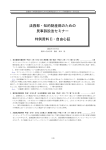
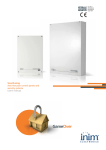
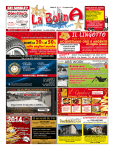
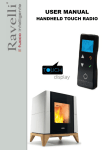
![Notice MULTICONTROL [1819 ko]](http://vs1.manualzilla.com/store/data/006376203_1-4176e050ac9817c2d5fce5980c13ff64-150x150.png)
